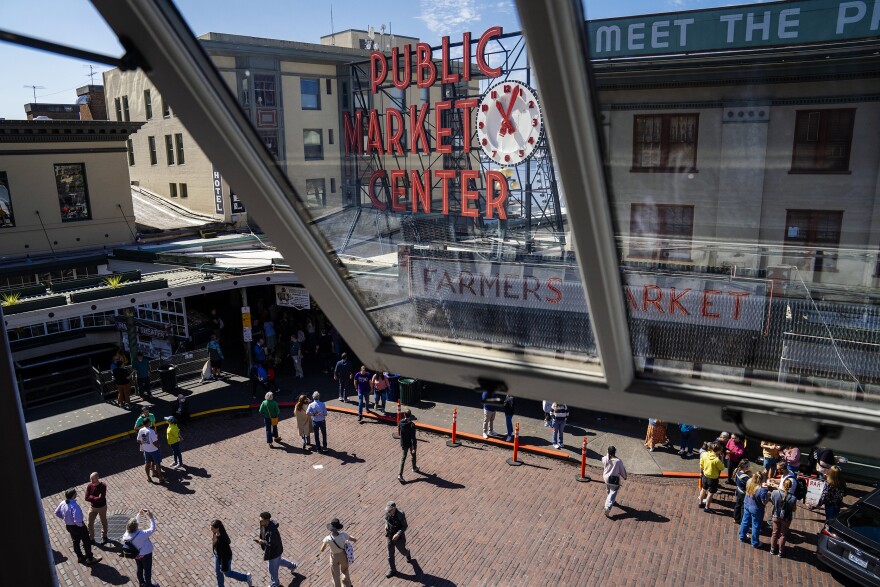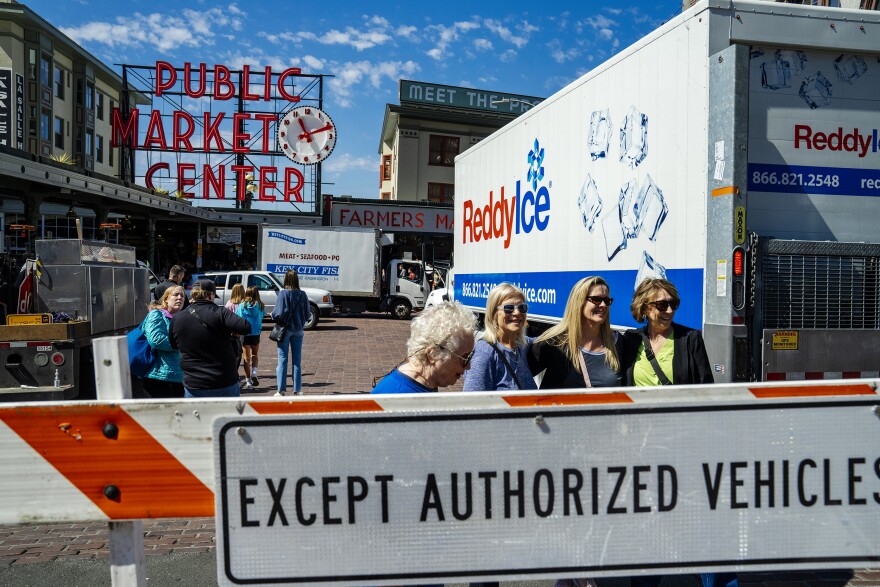Citing positive feedback, increased foot traffic and a need for more research, Seattle’s Pike Place Market is extending its car-free experiment through next spring.
Market leaders aren’t yet ready to pull the trigger on permanently restricting cars, but a return to the days of vehicular free-for-all — when tourist vehicles would awkwardly inch through summer crowds — is looking increasingly unlikely.
After decades of urging from pedestrian advocates, the Market started testing a car ban in late April. They launched a “limited vehicle access pilot” to restrict cars from driving through during daytime hours, with exceptions for delivery, pickup and emergency vehicles and cars with disabled parking passes.
The pilot project was originally tied to street repair work and slated to last through August. But as construction nears completion, Market leaders are now extending the pilot so they can study how vehicle restrictions play out during the Market’s quieter winter months.
“We need more time on it,” said Madison Douglas, a spokesperson for the Pike Place Market Preservation and Public Development Authority. “We’re realizing that we really need to continue to test and learn and see how the street is used in different times of the year.”
The extended pilot car restriction doesn’t have an specific end date. Sometime next spring, the Market plans to use what they’ve learned and adopt a “comprehensive street management plan” that can go into effect before the FIFA World Cup begins in June. It’s unclear exactly what that plan will look like, but it will likely include some sort of restriction on some types of cars.
“We’ve been hearing really good feedback,” Douglas said.

A 2021 poll by Seattle Neighborhood Greenways and the Northwest Progressive Institute found broad support for restricting cars in Pike Place.
The idea faced initial opposition from some vendors who worried that fewer people would shop at the Market if they couldn’t drive there. But the car restriction seems to have had the opposite effect.
Between January and June, foot traffic was up 7.5% compared to the same time period last year. It’s a “pretty significant” increase, Douglas said, adding that vendors are also reporting strong sales numbers.
Part of the uptick in visitors is probably attributable to the new Overlook Walk that opened last fall, Douglas said, but much of it seems to be driven by the new car policy that opened the streets and created a calmer environment for walkers.
“When you walk down the street, there’s a different energy to it,” Douglas said. “It’s really special.”
Feedback from vendors has been mostly positive, she said, but a “very small group” are still having a hard time adjusting. Some have raised concerns that the car ban makes it harder for “generational shoppers” (longtime regular customers) to access the Market.
The Market is taking that feedback seriously, Douglas said, and has already made changes to accommodate vendors’ concerns.
When the pilot launched, the vehicle restriction was in effect from 8 a.m. to 6 p.m. each day. But after hearing that some locals like to do their shopping quickly in the morning, Douglas said the Market decided to move the start time back to 10 a.m. The end of the vehicle restriction was changed from 6 p.m. to 4 p.m. (The hours when cars are restricted will be extended during holidays and other special events.)
“That was one piece of feedback we heard, so we jumped on that right away,” Douglas said. “We really wanted to make sure this is a locals’ market, and we really want to cater to locals.”
Douglas said feedback from visitors has been overwhelmingly supportive. She said she regularly hears people wondering why cars were ever allowed in the first place.
All stories produced by Murrow Local News fellows can be republished by other organizations for free under a Creative Commons license. Image rights may vary. Contact editor@knkx.org for image use requests.







